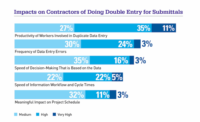Project goals mean very little if they aren’t accurately tracked, measured, and reported. Stakeholders involved in capital infrastructure projects regularly must weave sustainability goals into the fabric of capital projects from planning through to execution and completion to ensure that projects are finished on budget, on time, and with sustainability objectives met.
Making Construction Digital
To plan, track and measure against sustainability objectives at a regional and national level, project management software is often the solution. According to KPMG, too many construction projects still rely on “project management by spreadsheet,” leading to data duplication, erroneous or outdated reporting, data silos, and manual adjustments that allow human bias and ‘groupthink’ to paper over cracks and make project outcomes look better than they actually are. Capital project owners are encouraged to digitize their analytics and reporting in much the same way taxes and other forms of financial reporting have been digitized.
Capital infrastructure project managers can get ahead of legislation, such as New York's attempt to establishes a green development neighborhood tax exemption (the bill is currently in committee in the state senate) by digitizing their platforms will be able to demonstrate compliance with sustainability metrics more easily, making it easier for them to bid for and secure contracts.
The benefits of digitization extend beyond reporting. Capital projects typically involve billions of dollars, complex supply lines, costly materials, large work forces, and collaboration between various groups. Collaboration can be slowed to a crawl, or even stall altogether, if updates aren’t shared in real-time across various stakeholders, vendors, and project overseers. This is all but impossible to achieve with a “paper-based” system that depends on manual input, making it far more difficult to manage expectations and demonstrate which goals are being met and how. This isn’t sustainable — in every sense of the word.
Using Cloud Technology to Track Sustainability
Sustainability objectives are hard to define, but even harder to achieve. For every infrastructure project, sustainability goals must be defined and put into context — from where materials are being sourced to how they’re being delivered and used— and these parameters need to be included in the project from the earliest stages of planning in order to demonstrate the sustainability credentials of a new development. A cloud-based digitized framework with a universal interface will give each and every stakeholder access to the information they need in order to track projects at both a micro and macro level — including the project’s sustainability commitments and whether or not those commitments are being met. Small changes, such as disruptions to a supply line or a change in materials, can be communicated instantly, and also fed into a digitized model to assess the material impact on a project’s objectives.
Such digitized processes would also create historical records over time, which could then be used as a metric for future projects, reducing the time spent on planning and preparing. If a construction company already has a viable framework in place for the construction of a road or bridge, for instance, new variables can be fed into that framework to give an accurate indication of project time, spend, and environmental impact. How far will the materials need to travel? How many workers are involved? Which stakeholders will need to be consulted? All of these variables and more can be quickly accounted for with a workable digital system in place, ensuring that environmental goals are a core part of the project from the outset rather than an afterthought.
In almost all sectors, we’re seeing new regulations being attempted that demand greater transparency when it comes to capital infrastructure projects, and digitalization is key to delivering on transparency.
With a paper or spreadsheet-based system, project delays can be extremely difficult to predict and almost impossible to measure in terms of the overall impact they might have on a given project. This is one of the primary causes of frustration for stakeholders, whose expectations need to be managed more carefully. With a cloud-based system in place, project managers can “game out” scenarios that might cause delays, and give a more accurate reflection of how projects might be impacted. This carries the added bonus of being able to pinpoint how delays and other unforeseen events might impact the environment.
A paper-based contractor or construction manager might struggle to share how a month-long delay might impact a project’s environmental footprint; but a fully digitized one using cloud-based technology, however, would be able to provide an almost real-time indication of a project’s impact on the environment, from the smallest changes to the largest roadblocks.
Sustainability is not an end-state, it’s a process. Construction, at large, and those with their fingers on its purse strings are beginning to realize this, and new regulations are starting to emerge. The Federal Highway Administration has started a competitive grant program that aims to spark the use of advanced technology and software tools for highway and bridge projects. By embracing digitization now, contractors will ensure they are ready for the next wave of regulation or incentivization and are in the best possible position to bid on new projects and take them through to completion while meeting the complex sustainability objectives needed to create a cleaner, greener tomorrow.
Balaji Sreenivasan is the CEO and founder of Aurigo



Post a comment to this article
Report Abusive Comment